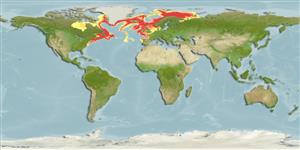Classificação / Names
Common names from other countries
Referência principal
Tamanho / Peso / Idade
Max length : 730 cm TL macho/indeterminado; (Ref. 247); Peso máx. publicado: 775.0 kg (Ref. 4699); Idade máx. registada: 392 anos (Ref. 110949)
Length at first maturity
Lm ?, range 244 - 427 cm
Ambiente
; marinhas; estuarina bentopelágico; intervalo de profundidade 0 - 2200 m (Ref. 247), usually 200 - 600 m (Ref. 35388)
Clima / Intervalo
Deep-water; 1°C - 12°C (Ref. 247), preferred 6°C (Ref. 107945); 83°N - 35°N, 95°W - 61°E
Distribuição
Descrição breve
Espinhos dorsais (total): 0; Raios dorsais moles (total): 0; Espinhos anais 0; Raios anais moles: 0; Vértebras: 41 - 44. A gigantic, heavily-bodied dogfish shark with a moderately long, rounded snout and small, low dorsal fins; lower caudal lobe long; upper jaw with small single-cusped teeth and lower jaw with moderate-sized, bent-cusped, slicing teeth (Ref. 5578). Medium grey or brown in color, sometimes with transverse dark bands or small light spots (Ref. 5578).
Categoria na Lista Vermelha da IUCN (Ref. 115185)
Ameaça para o homem
Poisonous to eat (Ref. 4690)
Utilização humana
Pescarias: pouco comercial; peixe desportivo: sim
Mais informação
ReferênciasAquaculturaPerfil para aquaculturaEstirpesGenéticaFrequência dos alelosHereditariedadeDoençasProcessamentoMass conversion
Ferramentas
Relatórios especiais
Descarregue XML
Fontes da internet
Estimates of some properties based on models
Phylogenetic diversity index
PD50 = 0.5313 many relatives (e.g. carps) 0.5 - 2.0 few relatives (e.g. lungfishes)
Nível Trófico
4.2 ±0.6 se; Based on diet studies.
Resiliência
Muito baixo, tempo mínimo de duplicação da população maior que 14 anos (Fec=10; assuming tm>10)
Vulnerabilidade
Very high vulnerability (90 of 100)
Categoria de preço
